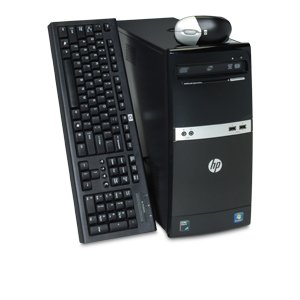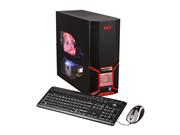Back To School Technology Buyer's Guide
by Zach Throckmorton on August 4, 2011 8:55 PM ESTRetail desktops
Component for component, retail desktops rarely offer as much value or flexibility as a comparable DIY desktop, especially if as a student you have access to heavily discounted OS licenses. However, retail desktops are often a good choice if the primary user is not especially tech-savvy. Retail desktops come with technical support and straightforward warranties. That is, they're potentially less of a headache in case something goes awry. When shopping for retail desktops, it is very important to shop around for remarkable sales. That said, we outline below what you can typically expect at four different price points.
Less than $300

At $300, retail desktops typically feature previous-generation CPUs, less than 4GB of memory, smaller hard drives, and integrated (i.e. non-gaming) graphics. That said, these very inexpensive PCs are still up to basic productivity tasks like web browsing and document creation, as well as sound and video playback. The Acer Veriton VX275-UD5800W is an example of such a computer. Its dual-core Intel Pentium E5800 processor is based on a CPU architecture that is now two generations old, it has 2GB of RAM, and a 320GB hard drive. It's an attractive choice for college students because it's tiny—16" deep by 4" wide by 11" tall. Its 4" width is a small desk footprint; it could easily be placed on a typical dorm room desk while leaving plenty of room for other items. Considering the very low cost of RAM, upgrading it to a more comfortable 4GB would cost less than $15.
Around $400

At $400, give or take, retail desktops start having good enough hardware that you can get four years of basic usage from them. Budget current-generation processors, 4GB RAM, smaller hard drives, and integrated graphics are typical in this price range. HP's 505B has specifications similar to the AMD micro-ATX system outlined on the previous page. The most important difference is the HP's PSU is 300W, and like most retail computer PSUs, it's likely not even capable of supplying that much electricity. The weak PSU severely limits this system's expandability in terms of adding more hard drives or a GPU. Also, the HP case is not nearly as attractive as the Fractal Core 1000! That said, it's a solid value at just over $400.
Around $500

As a long-time computer enthusiast, it truly amazes me how much power can be purchased for $500 today. At $500, lower mid-range CPUs, more than adequate 6GB or 8GB of memory, and large hard drives abound, though these systems usually lack discrete GPUs (if you're not gaming, this does not matter). The Gateway DX4850-45u is exactly $500, has a quad core Intel Core i5 CPU, 6GB DDR3, and a 1TB hard drive. This system is respectably powerful today, and it will be very serviceable in four years. Its chassis also includes a few niceties like easily-accessible media card readers and more than typical USB ports. Its optical drive not only reads and writes CDs and DVDs, it can also read Blu-ray discs. WiFi is integrated. Unfortunately it also includes an anemic 300W PSU, so upgrading it with anything more powerful than a low-end gaming GPU will require upgrading the power supply as well.
Around $700

At $700, retail PCs typically contain higher mid-range processors, 8GB RAM, large hard drives, and begin to include decent gaming GPUs. You usually get better bang for the buck at this point if you get away from the Dell and HP systems, where there's a major premium for decent graphics cards, and that's what we've selected here. CyberpowerPC's Gamer Xtreme 1314 houses the very capable Intel Core i5-2500K CPU, 8GB memory, a 1TB hard drive, and an AMD Radeon HD 6670 GPU. AnandTech reviewed the 6670 a few months ago and found it to be capable of producing acceptable frame rates (i.e. 30FPS or higher) in most games at resolutions less than 1080p and medium settings. The 6670 is not an enthusiast gamer's card, but it's okay for casual gamers, or hardcore gamers who like older titles (think World of Warcraft). Unfortunately, its motherboard will not facilitate overclocking the Core i5-2500K. Note that as the cost of the retail PC has risen on this page, so has its performance discrepency with the comparable DIY system. The Intel Core i5-2500K-based PC on the previous page has an enthusiast gamer-grade GPU, an SSD, a more feature-rich and overclockable motherboard, an aftermarket CPU heatsink for better overclocking results, and a much higher quality power supply for less than $100 more than this retail PC.
Now that we've covered both build your own and pre-built systems, the next page looks at what you'll actually be looking at: monitors.










94 Comments
View All Comments
Gigantopithecus - Friday, August 5, 2011 - link
After thinking about this and on the advice of Ryan, our GPU guru, I edited the article to recommend nothing more power-hungry than a 6870. That's a more comfortably conservative recommendation, and I think it's better to err on the side of caution.mariush - Saturday, August 6, 2011 - link
That's indeed better.A lot of the pre-built computers still come with very cheap power supplies based on old designs with lots of amps on 3.3v and 5v and not so much on 12v, so those 220 watts could be a bit too much for these power supplies.
Someone might get mixed up and think that any kind of 400w power supply would be capable of this, which is of course not true.
Hrel - Thursday, August 4, 2011 - link
I would like to add a set I've had some personal experience with that are excellent. Sound is crystal clear, I'm not kidding. NO distortion even at max volume! Satisfying Bass.http://www.amazon.com/Onkyo-HTX-22HDX-Ultra-Compac...
It's got a 1% THD rating, so you can believe me when I say there really is no distortion. The bass isn't quite as good as those klipsch, which I've also used. But it is full and satisfying for 90-99% of uses. Not quite as penetrating as the Klipsch so your neighbors will thank you. Also doesn't get quite as loud as those Klipsch, but more than loud enough for realistic uses. Especially in a dorm/apartment. Has a night time mode that's actually usefull and many settings. And unlike all the other systems you linked it has a full receiver built into it. Full HDMI support and all the hookups you could ever want. That way you can get your game system and pc and laptop all running through it. With a remote so you don't have to get up every time you want to change devices. On top of that it supports 3 more speakers than the ones included so you could have a full 5.1 surround sound set up down the road if you chose to. Maybe after college, or once you get a bigger apartment or house or something. I often find them on newegg for 250 or less. Right now they're 230 on amazon. Really amazing deal for everything you get. Chintzy controller, but at this price all that matters is it works, and it does. If that matters to you get a Logitech universal remote.
Personally I use this when I want music streaming from my computer but I'm playing a game online over xbox. I don't really care about the explosion sounds of the game, but I need to visuals going to the tv. But I can have the sound coming from the computer without ever getting up or moving any cables. Pretty convenient and very fairly priced for everything you're getting.
If you're building a dedicated home theatre room you need to spend more; period. But if you don't want to spend more than 250 or so. Or you have limited space or don't want to fuss with cables or just want quality sound and bass without too much hassle or money; that's what these are for. The only other option I think is the Klipsch, which have slightly superior sound but have no receiver, and don't even have optical audio. That last one was a bid deal to me; too much distortion over RCA. I think the Onkyo offering a full receiver with every connection you could ever want, remote, 2 quality speakers with a good sub-woofer and the option to go 5.1 surround sound later more than makes up for the "just slightly" inferior sound. I mean, honestly unless you're completely OCD about sound like I am, you probably won't even notice a difference. Anyway, I think they're a great set of speakers and wanted to spread the word where the word just might be listened to, and appreciated.
Chinoman - Friday, August 5, 2011 - link
I agree with getting a system which has a low-powered sub for decreased penetration. As a current college student, it seems to me that a lot of kids who move on campus don't realize that their 10" subwoofers can be heard just as well on the other side of the wall.Leave the "loud music" to the clubs, don't bring it to the dorms where people next door might be trying to sleep or study.
Zoomer - Friday, August 5, 2011 - link
I would recommend picking up a cheap but decent receiver from craigslist for $50++ and using that. It just needs to do at least 2 channels (or 5), and there are many receivers out there that are good quality, but doesn't support hdmi switching or what not. It's not really necessary anyway. Save the money for the speakers; you'll find that HDMI switching, crazy fancy features and what not doesn't matter as much as the speakers.Roland00Address - Thursday, August 4, 2011 - link
They were planning to but they removed it before it was released (May of 09 they removed the 3 app limit, windows 7 starter like the rest of windows 7 was released to oems in July of 09 and to the general public in Oct of 09.)Gigantopithecus - Thursday, August 4, 2011 - link
Thanks Roland! Edited the article accordingly after confirming with a friend who just got the 1001P. The first thing I do when I buy a new machine (or as happens more often, a friend brings me their new machine) is install one of those heavily discounted W7 Ultimate licenses. Admittedly I have little experience with W7 Starter. ;)Roland00Address - Friday, August 5, 2011 - link
If you are a student and you can get W7 Ultimate or W7 Pro for cheap through your campus book store, then you will want to hop onto it.W7 Premium, Pro, and Ultimate add back the Windows 7 Media Center functionality.
W7 Pro and Ultimate add the remote desktop so you can log back on in your Desktop at the Dorm and grab the file you forgot to save, and have it sent back to your netbook.
Zoomer - Friday, August 5, 2011 - link
Or Pro for free through MSDNAA.johnnywa - Friday, August 5, 2011 - link
I find it wrong to assume that you can't get a desktop-like experience out of a laptop, but the article does seem to reinforce this notion. With a laptop, you can still purchase a monitor (or small TV), keyboard, and mouse, and you can end up with essentially a desktop that you can unhook and take around with you when you need to. I tried this solution for the last 2 years (minus monitor, although sometimes I hooked my lappy up to our apartment's 37" TV), and it was a very comfortable setup. Of course this isn't an end-all-be-all solution, but I'd say it's another alternative to desktop + netbook.